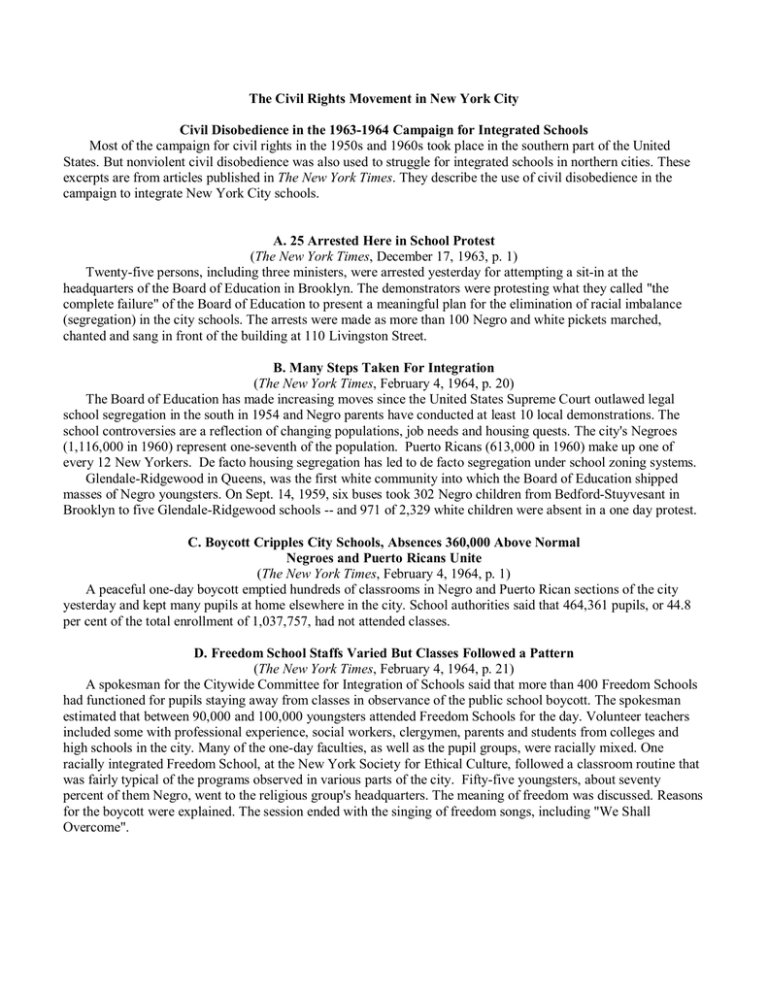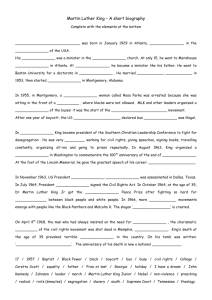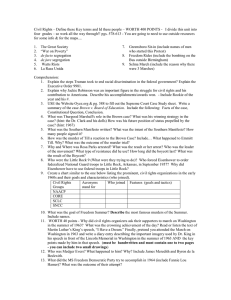The Civil Rights Movement in New York City
advertisement

The Civil Rights Movement in New York City Civil Disobedience in the 1963-1964 Campaign for Integrated Schools Most of the campaign for civil rights in the 1950s and 1960s took place in the southern part of the United States. But nonviolent civil disobedience was also used to struggle for integrated schools in northern cities. These excerpts are from articles published in The New York Times. They describe the use of civil disobedience in the campaign to integrate New York City schools. A. 25 Arrested Here in School Protest (The New York Times, December 17, 1963, p. 1) Twenty-five persons, including three ministers, were arrested yesterday for attempting a sit-in at the headquarters of the Board of Education in Brooklyn. The demonstrators were protesting what they called "the complete failure" of the Board of Education to present a meaningful plan for the elimination of racial imbalance (segregation) in the city schools. The arrests were made as more than 100 Negro and white pickets marched, chanted and sang in front of the building at 110 Livingston Street. B. Many Steps Taken For Integration (The New York Times, February 4, 1964, p. 20) The Board of Education has made increasing moves since the United States Supreme Court outlawed legal school segregation in the south in 1954 and Negro parents have conducted at least 10 local demonstrations. The school controversies are a reflection of changing populations, job needs and housing quests. The city's Negroes (1,116,000 in 1960) represent one-seventh of the population. Puerto Ricans (613,000 in 1960) make up one of every 12 New Yorkers. De facto housing segregation has led to de facto segregation under school zoning systems. Glendale-Ridgewood in Queens, was the first white community into which the Board of Education shipped masses of Negro youngsters. On Sept. 14, 1959, six buses took 302 Negro children from Bedford-Stuyvesant in Brooklyn to five Glendale-Ridgewood schools -- and 971 of 2,329 white children were absent in a one day protest. C. Boycott Cripples City Schools, Absences 360,000 Above Normal Negroes and Puerto Ricans Unite (The New York Times, February 4, 1964, p. 1) A peaceful one-day boycott emptied hundreds of classrooms in Negro and Puerto Rican sections of the city yesterday and kept many pupils at home elsewhere in the city. School authorities said that 464,361 pupils, or 44.8 per cent of the total enrollment of 1,037,757, had not attended classes. D. Freedom School Staffs Varied But Classes Followed a Pattern (The New York Times, February 4, 1964, p. 21) A spokesman for the Citywide Committee for Integration of Schools said that more than 400 Freedom Schools had functioned for pupils staying away from classes in observance of the public school boycott. The spokesman estimated that between 90,000 and 100,000 youngsters attended Freedom Schools for the day. Volunteer teachers included some with professional experience, social workers, clergymen, parents and students from colleges and high schools in the city. Many of the one-day faculties, as well as the pupil groups, were racially mixed. One racially integrated Freedom School, at the New York Society for Ethical Culture, followed a classroom routine that was fairly typical of the programs observed in various parts of the city. Fifty-five youngsters, about seventy percent of them Negro, went to the religious group's headquarters. The meaning of freedom was discussed. Reasons for the boycott were explained. The session ended with the singing of freedom songs, including "We Shall Overcome". Civil Disobedience in the 1963-1964 Campaign for Integrated Schools 1- Reverend Milton Arthur Galamison, The New York Times, December 17, 1963, p. 43 Associates (friends) of the Rev. Milton Arthur Galamison were not surprised yesterday when he was arrested for the third time as a result of his leadership among New York City Negroes in their campaign for civil rights. Over the last 10 years Mr. Galamison has become increasingly active in trying to gain better schools, better jobs and better treatment generally for his fellow Negroes in the city. Last summer he was one of six ministers who negotiated with Governor Rockefeller to end reported discrimination on public projects. Reverend Adam Clayton Powell, Jr., The New York Times, February 3, 1964, p. 18 From his pulpit at the Abyssinian Baptist Church, the Rev. Adam Clayton Powell Jr., who is also a Democratic member of Congress, said "I am back of Reverend Galamison and the school boycott 100 per cent." Mr. Powell said that it was his "hope and prayer" that there would be no violence today and that the boycott should "become a national boycott." Reverend Dr. M. Moran Weston, The New York Times, February 3, 1964, p. 18 At St. Philip's Protestant Church, the Rev. Dr. M. Moran Weston said that "keeping children out of school is not an effective answer to poor and segregated public schools." He said the school crisis was the "result of many factors within and outside the control of the Board of Education." 2- Dr. John C. Bennett, Union Theological Seminary, The New York Times, February 4, 1964, p. 21 "I think the white people are so far removed from the real dynamics of the problem that Negroes have to apply more and more pressure. Without pressure, the white people always postpone. They never do enough." Dr. John H. Fischer, president, Teachers College, The New York Times, February 4, 1964, p. 21 "The very idea of the boycott was a mistake from the beginning to what I hope will now be the end....(It is) an effort to force a situation that by its very nature is not subject to the use of force." Rabbi Max Schenk, Brooklyn, The New York Times, February 4, 1964, p. 21 "(My) sympathies are with the people of the section and their impatience with the slowness of integration. They've been waiting now 100 years." 3- Dr. Ralph Bunche, United Nations, The New York Times, February 4, 1964, p. 21 "I'm glad this demonstration was effective, but I don't have any illusion about how deeply it goes in resolving the fundamental (main) problem -- the problem of racial ghettoes." Bayard Rustin, The New York Times, February 4, 1964, p. 20 Mr. Rustin took on the directorship of the boycott without pay. (Bayard Rustin) said that "while the civil rights movement must continue its protest in the streets, we must realize that we don't possess the economic power to bring about this social change alone." This leads him to think that perhaps it is time for the Negro civil rights proponents (supporters) to seek an alliance with other liberal sources of power, the labor unions, particularly. 4- New York Times Editorial, February 3, 1964, p. 26 The boycott is pointless. It uses the methods of unreason to force integration in ways that endanger educational progress, rather than advance it. Great improvements are needed in the city's school system. Especially needed is a dramatic attempt to reach and educate the children of the slums so that they can take their place in American society as equals in skill and training. New York Times Editorial, February 4, 1964, p. 32 The great majority of New Yorkers, and certainly all members of the Board of Education, agree that integration is a priority goal and would, in fact, be the way of life in all the city's schools except for the barriers set up by the housing pattern and the composition of the population. A racial balancing of all the city's schools remains as impossible after the boycott as before.


